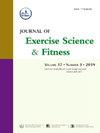同时训练顺序对肥胖年轻男性身体活动、身体组成和健康的影响:一项为期12周的随机对照试验
IF 2.4
2区 医学
Q2 SPORT SCIENCES
引用次数: 0
摘要
目的本研究探讨了不同的同步训练序列对年轻肥胖男性身体活动(PA)、身体成分和身体健康的影响。我们还调查了这些干预措施在降低体脂率(BF%)方面的有效性是否受到PA水平的影响。方法对45例肥胖青年男性(平均年龄:22.42±1.96岁,平均BMI: 29.78±3.37)进行为期12周的随机对照试验。参与者被随机分为三组:CRE组(阻力训练(RT) +耐力训练(ET)), CER组(ET + RT)和对照组(Con)。培训课程每周举行三次。测量,包括PA水平,体成分,骨密度,最大摄氧量和肌肉力量,在干预前后进行评估。结果与基线时相比,干预后,CRE组和CER组在PA水平、体成分、骨密度、最大摄氧量和肌肉力量等各项参数均有显著改善(p <;0.05), Con组无显著变化(p >;0.05)。具体而言,CRE组表现出显著的进展,MVPA水平升高(η2p = 0.37, p <;0.001),脂肪量减少(η2p = 0.28, p <;0.001), BF% (η2p = 0.28, p <;0.001), android fat (%) (η2p = 0.21, p <;0.001),雌蕊脂肪(%)(η2p = 0.30, p <;0.001),最大强度(η2p = 0.20, p = 0.008)、爆炸强度(η2p = 0.38, p <;0.001),肌肉耐力(η2p = 0.55, p <;0.001),超过了在CER组和Con组观察到的改善。干预期间PA水平的变化影响CT降低BF%的效果。结论:ct,特别是当RT在ET之前,有可能改善肥胖年轻男性的PA水平、整体身体健康、身体成分和骨骼健康。此外,干预期间PA水平的变化影响了CT降低BF%的有效性。试验注册chictr, ChiCTR2200063892。本文章由计算机程序翻译,如有差异,请以英文原文为准。
Impact of sequence in concurrent training on physical activity, body composition, and fitness in obese young males: A 12-week randomized controlled trial
Objectives
This study examined how different sequences of concurrent training impacted physical activity (PA), body composition, and physical fitness in young obese males. We also investigated whether the effectiveness of these interventions in reducing body fat percentage (BF%) was influenced by PA levels.
Methods
A 12-week randomized controlled trial involving a cohort of 45 obese young males (mean age: 22.42 ± 1.96 years, mean BMI: 29.78 ± 3.37) was conducted. Participants were randomly assigned to three groups: the CRE group (Resistance Training (RT) followed by Endurance Training (ET)), the CER group (ET followed by RT), and the control group (Con). The training sessions were held three times a week. Measurements, including PA level, body composition, bone density, VO2max, and muscle strength, were assessed before and after the intervention.
Results
Compared to those at baseline, following the intervention, both the CRE and CER groups showed significant improvements in various parameters, including PA level, body composition, bone density, VO2max, and muscle strength (p < 0.05), whereas no significant changes were observed in the Con group (p > 0.05). Specifically, the CRE group demonstrated remarkable progress, as evidenced by an increase in MVPA level (η2p = 0.37, p < 0.001), a reduction in fat mass (η2p = 0.28, p < 0.001), BF% (η2p = 0.28, p < 0.001), android fat (%) (η2p = 0.21, p < 0.001), gynoid fat (%) (η2p = 0.30, p < 0.001), and various physical fitness indices, such as maximum strength (η2p = 0.20, p = 0.008), explosive strength (η2p = 0.38, p < 0.001), and muscular endurance (η2p = 0.55, p < 0.001), surpassing the improvements observed in the CER and Con groups. Changes in PA levels during the intervention influence the efficacy of CT in reducing BF%.
Conclusion
CT, particularly when RT precedes ET, had the potential to improve PA levels, overall physical fitness, body composition, and bone health in obese young males. Moreover, changes in PA levels during the intervention impacted the effectiveness of CT in reducing BF%.
Trial registration
ChiCTR, ChiCTR2200063892.
求助全文
通过发布文献求助,成功后即可免费获取论文全文。
去求助
来源期刊
CiteScore
5.10
自引率
3.60%
发文量
54
审稿时长
31 days
期刊介绍:
The Journal of Exercise Science and Fitness is the official peer-reviewed journal of The Society of Chinese Scholars on Exercise Physiology and Fitness (SCSEPF), the Physical Fitness Association of Hong Kong, China (HKPFA), and the Hong Kong Association of Sports Medicine and Sports Science (HKASMSS). It is published twice a year, in June and December, by Elsevier.
The Journal accepts original investigations, comprehensive reviews, case studies and short communications on current topics in exercise science, physical fitness and physical education.

 求助内容:
求助内容: 应助结果提醒方式:
应助结果提醒方式:


